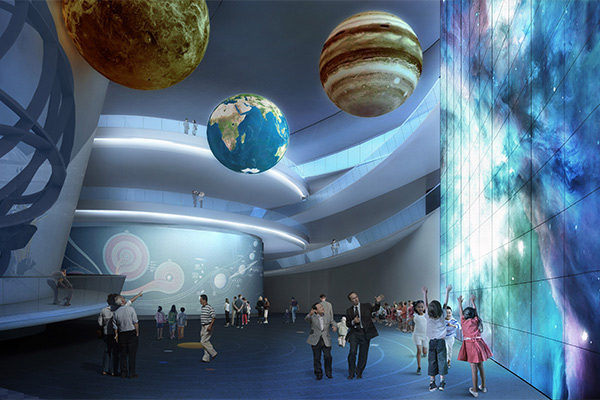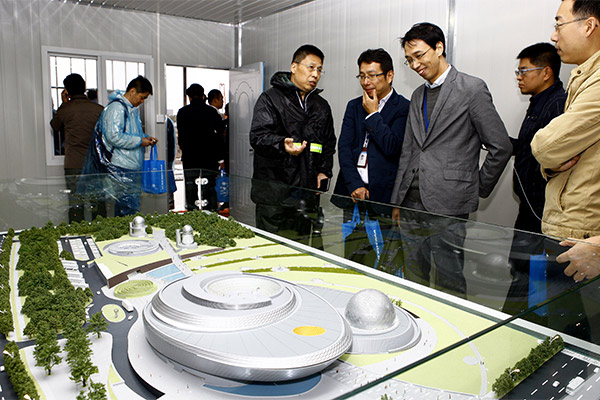
A rendering is presented during the foundation laying ceremony of the Shanghai Planetarium in Shanghai, east China, Nov 8, 2016. Covering an area of 38,164 square meters, the planetarium will include a main building and ancillary constructions, such as an observation base for young people, a solar tower and observatory.[Photo/Xinhua]
The groundbreaking ceremony for the world’s largest planetarium kicked off in Shanghai on Nov 8, with the facility scheduled to open in 2020.

Guests attend the foundation laying ceremony of the Shanghai Planetarium in Shanghai, east China, Nov 8, 2016. Covering an area of 38,164 square meters, the planetarium will include a main building and ancillary constructions, such as an observation base for young people, a solar tower and observatory.[Photo/Xinhua]
Located on Lingang Avenue in the Pudong New Area, the Shanghai Planetarium covers more than 58,600 square meters and cost 528 million yuan ($77.9 million). It consists of a main building, a public observatory, a tower telescope, an observation site for youths and a restaurant.
When completed, it will be the second comprehensive planetarium on the Chinese mainland, following the Beijing Planetarium. People will be able to observe the galaxy, learn about astronomy and experience using observation instruments.
“It’s been a dream of many scientists and amateur astronomers for nearly half a century to build a planetarium in Shanghai,” said Gu Qingsheng, deputy director of Shanghai Science and Technology Museum and commander-in-chief of the construction headquarters of Shanghai Planetarium.
Since the 1970s, scientists have been appealing to build a planetarium in Shanghai, aiming to arouse interest in astronomy among young people and help cultivate talents for China’s space exploration.
The project was approved in 2014, and the preliminary design and budget were passed in July.
The new planetarium was planned for the Lingang area because there is not much light pollution there, making it one of the best places in Shanghai for observation.
Designed by Ennead Architects of the United States and Shanghai Xian Dai Architectural Design (Group) Co, its main building has three oval structures, which symbolize the moving orbits of the celestial bodies and the law of universal gravitation.
The landscape outside the main building contains four non-concentric walking paths extending outward, a symbol of the spiral of the galaxy.
Xu Xiaohong, an official at the construction headquarters of Shanghai Planetarium, said that it is difficult to construct such a huge irregular-shaped building, so the company produced a three-dimensional model of the building using computer software, which will be applied in the design, construction, operation and maintenance of the building.
The theme of the planetarium will be “Connecting People and the Universe”. The main exhibition area is divided into three zones: Home, Universe and Journey.
The Home area is an exhibition of the sun, earth and moon, where visitors can wander around the solar system and across the galaxy.
The Universe area exhibits all the wonderful phenomenon in the universe, from the perspectives of time, space, light, gravity, elements and life, revealing the evolution and operation of celestial bodies.
The Journey area contains an exhibition of the great journey of space exploration of humans and a vision of the future, aiming to inspire people’s thinking and perception.
Experiences are one of the major highlights of the Shanghai Planetarium, officials said. The observatory will be equipped with large-caliber telescopes, allowing people to observe a variety of celestial bodies.

Guests visit the model of the Shanghai Planetarium during its foundation laying ceremony in Shanghai, east China, Nov 8, 2016. Covering an area of 38,164 square meters, the planetarium will include a main building and ancillary constructions, such as an observation base for young people, a solar tower and observatory.[Photo/Xinhua]
